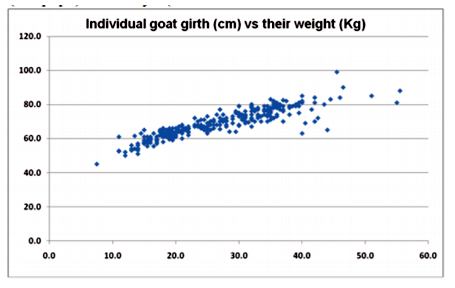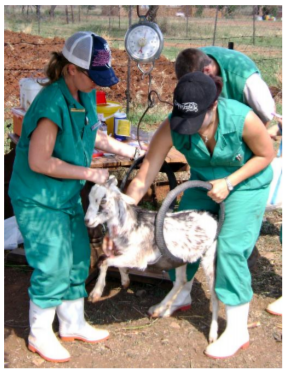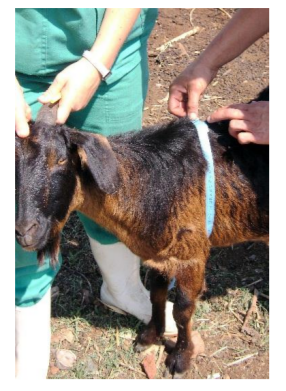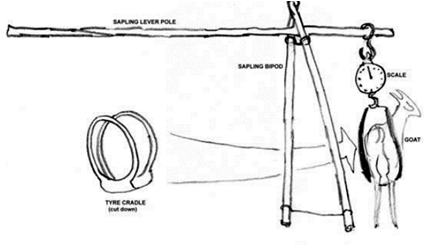Information
Journal Policies
A Girthtape for Indigenous Goats in Africa
A.M. Botha1*, G.F. Bath1
Copyright :© 2018 Authors. This is an open-access article distributed under the terms of the Creative Commons Attribution License, which permits unrestricted use, distribution, and reproduction in any medium, provided the original author and source are credited.
The objective of this study was to provide a practical solution to determine bodyweight of indigenous goats for those farmers that cannot purchase their own weighing scale. Bodyweights are important for accurate dosing, marketing and management decisions.
Data was collected from 287 indigenous goats of different ages, sexes and pregnancy status and on commercial, communal and research stations in Gauteng, North West and Limpopo provinces of South Africa. An overall correlation coefficient between heart girth and body weight of 0.851 was found in this study. There was little variation resulting from paramenters like breeding status and age. This study indicated that there is a high degree of correlation between heart girth measurement and body weight and therefore measurement of heart girth can be used in predicting the body weight of indigenous goats. A customized tape measure that reads directly in kilograms can therefore be developed.
Girthtape; Indigenous goats; Body weight,Animal and Veterinary Sciences
1. Introduction
Strong correlations (up to 0.95) between live bodyweight and girth circumference have been demonstrated in various species like horses, cattle, pigs, sheep and goats (Atta et al., 2004. De Villiers et al., 2009. Ellis et al., 2009. Goe et al., 2001). However our observations in South Africa are that these correlations do not always hold true between different breeds and especially between exotic and indigenous breeds. Therefore to be useful in the African context, a correlation needs to be established for indigenous breeds. This would allow for the development of a weighband where the estimated weight could be read off directly from a specially calibrated girth tape.
De Villiers et al., 2009 collected data from 1202 goats in Kwazulu-Natal Province. A wide range of breeds, farming systems and animal classes were covered. The regression coefficient between body weight and heart girth overall was 0.895.
Goats in developing countries are considered one of the most important farm animals for the small-scale farmers, providing them with meat, milk, skins and manure (Peacock et al., 2005). Goats, chickens and cattle are the most frequently kept livestock by people living in the small-scale farming systems (De Villiers & Letty, 2001). Income derived from livestock production is a major contributor to the livelihoods of rural people. Livestock are a form of capital that is easily converted into cash (Rocha et al., 1991 and Nsoso et al., 2003). Goats not only play a vital role in South Africa but are of great importance all over the world. In Botswana the indigenous sheep and goats provide income, employment and food security for the resource-poor farmers (Nsoso et al., 2004).
Internal helminth parasites are an important cause of disease in goats in the rural areas of KwaZulu-Natal. In order to administer the correct dose of medication whether by injection or orally, it is absolutely essential to know the live body weight of the animal to be treated (Vatta et al., 2002). The ability of smallholder farmers and animal health workers to estimate live bodyweight can critically affect the likelihood of under- or over-dosing of veterinary compounds in decentralised systems where farmers administer a significant proportion of the veterinary treatments (Machila et al., 2008). Knowing the body weight of a goat is important for a number of other reasons, such as for breeding, correct feeding and health (Slippers et al., 2000).
The purpose is to develop a weigh band suitable for use in indigenous goats in Africa, thus enabling small scale farmers with limited resources to weigh their animals accurately and consequently make treatment dosages correctly, as well as enabling farmers to monitor weight changes so as to make rational and accurate management decisions on nutrition and breeding.
2. Material And Methods
Data collected from goats was as follows: Weight: in kg, to nearest half kg; Girth: in cm, to nearest half cm; different ages (teeth): 0, 2, 4, 6, 8 & W; Sex: M (male), F (female) & C (castrate); Breeding status (female only): D (dry), P (pregnant) & L (lactating); and Condition Score (BCS): 1,2,3,4,5. Goats used for this study were from the following areas: Onderstepoort (Gauteng), Irene (Gauteng), Makapanstad (Limpopo), Mara (Limpopo) & Rosslyn (North West) (commercial, communal and research stations). Data was collected from 287 goats, (229 female and 58 males). Of the does, 51.5% were classified as dry, 22.7% were heavily pregnant and 25.8% were lactating. Of the males, 86.2% were kapaters (castrates) and only 13.8% were entire bucks. Goats used were indigenous goats and indigenous goat crosses. The equipment used included an accurate hanging scale reading up to 150kg, stout sapling pole ± 2 1/2 - 3 m long, supporting bipod sapling poles ± 11/2 m high, 8 gauge wire hook and an old tyre for a cradle (see figure 2 and 4), and a 2m measuring tape (figure 3). At one research station, an electronic scale was used.
Data was analysed for correlations using Microsoft office Excel 2003 as well as MINITAB 14.
3. Discussion
The results of this investigation are largely in accord with previous findings (de Villiers et al., 2009, Nsoso et al., 2003, Slippers et al., 2000, Goe et al., 2001, Ellis et al., 1998) and therefore support the conclusion that the heart girth measured just behind the elbows is highly correlated (r2 = 0,851) with body weight. Thus implies that a girth tape that measures not in centimeters, but rather directly in kilograms, can be made and used by small scale goat farmers to measure the weight of their animals with sufficient accuracy for commercial farming purposes, and at a cost that will be easily within reach of even the most severely disadvantaged farmers.
The study measured mainly does in the reproductive stages but this need not be seen as a drawback since the majority of goats kept for commercial purposes should be in this category. More refinements are possible in future but this does not preclude the implementation of this indirect measure of body weight in indigenous African goats.
Recommendation
It is recommended that funding be sourced to allow for the design, development and distribution of goat heart girth tapes specifically made for indigenous African goats. This will be of immediate use to small scale farmers and allow them to give accurate doses of drugs, measure growth rates and determine the value of animals for sale.
Acknowledgments
We thank the Ford Motor Company (South Africa) for the loan of a pick-up vehicle to allow us to carry out this study, and Prof KP Pettey, Dr D Blignaut, Mr U Njenjani and Mr M Ngcobo for assisting me with the measurements.
References
- Atta, M., El Khidir, O.A., 2004. Use of heart girth, wither height and scapuloischial length for prediction of live weight of Nilotic sheep. Small Rum. Research. 55, 233-237.
- De Villiers, J.F., Letty, B.A., 2001. Information collected during the dignostic phase in the Nkwezela Sub-Ward. Hlanganini District. KZN Agri Report N/A/2001/68. Farming Systems Research Section, KwaZulu-Natal Department of Agriculture and Environmental Affairs, Hilton, South Africa.
- De Villiers, J.F., Gcumisa, S.T., Gumede, S.A., Thusi, S.P., Dugmore, T.J., Cole, M., du Toit, J.F., Vatta, A.F., Stevens, C., 2009. Estimation of live body weight from the heart girth measurement in KwaZulu-Natal goats. Applied Animal Husbandry & Rural Development, 2, 1-8.
- Ellis, J.M., Hollands, T., 1998. Accuracy of Different Methods of Estimating the Weight of Horses, Veterinary Record. 143, 335-336.
- Goe, M.R., Alldredge J.R., Light, D., 2001. Use of heart girth to predict body weight of working oxen in the Ethopian highlands. Livestock Production Science. 69, 187-195.
- Machila, N., Fevre, E.M., Maudlin, I. Eisler, M.C., 2008. Farmer estimation of live bodyweight of cattle: Implications for veterinary drugs dosing in East Africa. Preventive Veterinary Medicine. 87, 394-403.
- Nsoso, S.J., Aganga, A.A., Moanetsi, B.P. Tshwenyane, S.O., 2003. Body weight, body condition score and heart girth in Indigenous Tswana goats during the dry and wet seasons in Southeast Botswana. Livestock Research for Rural Development. 15, 4 (on-line edition at http://www.lrrd.org/ lrrd15/ 4/ nsos154.htm, 2011)
- Nsoso, S.J., Podisi, B., Otsogile, E., Mokhutshwane, B.S., Ahmadu, B., 2004. Phenotypic characterization of indigenous Tswana goats and sheep breeds in Botswana: continuous traits. Tropical Animal Health and Production. 36, 789-800.
- Peacock, C., Devendra, C., Ahuya, C., Roets, M., Osafo, E., 2005. Goats. In E. Owen, A. Kitalyi, N. Jasuriya, T. Smith (Eds.), Livestock and wealth creation. Improving the husbandry of animals kept by resource-poor people in developing countries. University Press, Nottingham, pp. 361-385.
- Rocha, A., Starkey, P., Dionisio, A.C., 1991. Cattle production in smallholder farming systems in Southern Mozambique. Agricultural Systems. 37, 55-75.
- Sarti, F.M., Castelli, L., Bogani, D., Panella, F., 2003. The measurement of chest girth as an alternative to weight determination in the performance recording of meat sheep. Italian Journal Animal Science. 2, 123-129.
- Slippers, S.C., Letty, B.A., De Villiers, J.F., 2000. Predicting the body weight of Nguni goats. South African Journal of Animal Science. 30, 127-128.
- Vatta, A.F., Krecek, R.C., Letty, B.A., Van der Linde, M.J., Grimbeek, R.J., De Villiers, J.F., Motswatswe, P.W., Molebiemang, G.S., Boshoff, H.M., Hansen, J.W., 2002. Incidence of Haemonchus spp. And effect on haemotocrit and eye colour in goats farmed under resource-poor conditions in South Africa. Veterinary Parasitology. 103, 119-131.









